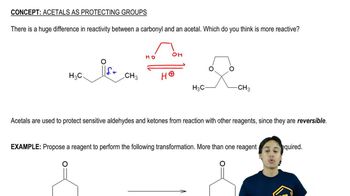For each of the following reactions, identify the bonds that are broken and formed. Be sure to indicate whether the bond that is broken is a σ bond or a π bond.
(c)
 Verified step by step guidance
Verified step by step guidance Verified video answer for a similar problem:
Verified video answer for a similar problem:



 7:16m
7:16mMaster Mechanism of Silyl Ether Protecting Groups. with a bite sized video explanation from Johnny
Start learning